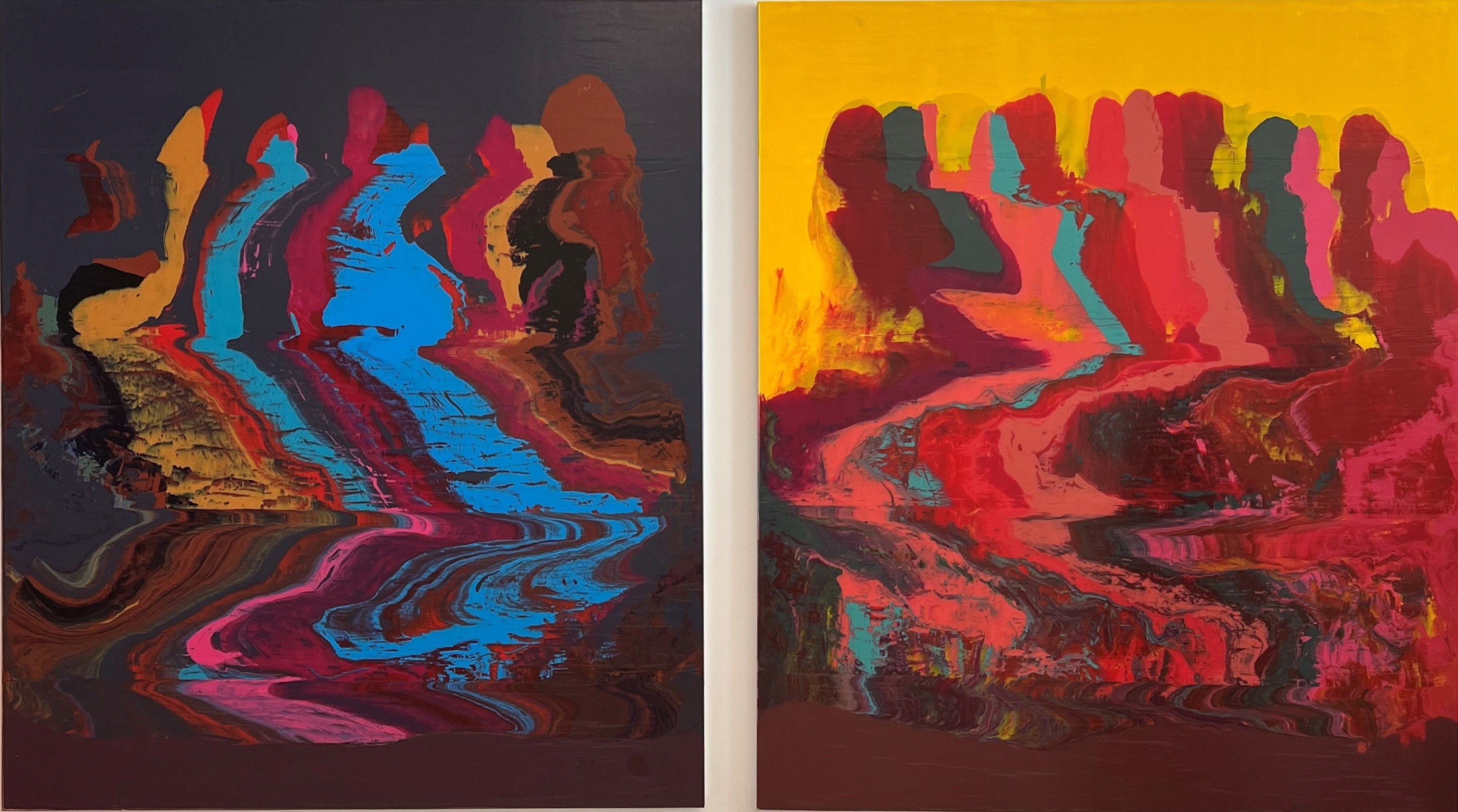
81 Designs
eL Seed, Bouchra Bodoua, Hazem Harb, Naqsh Collective, and Richard Yasmine
Interwoven, 2023
Made of cross stich, canvas and recycled rubber
55 cm in diameter, Weight 1.5 kg with base
Courtesy of the artists and 81 Designs, Abu Dhabi
Adorned with intricately stitched fabric using the ancient embroidery technique of Tatreez, each stability ball in this installation represents a harmonious blend of art and functionality. Tatreez, which traces its origins back 3000 years ago to the Canaanite era, is deeply rooted within a larger narrative space that reflects Palestinian cultural heritage through matrilineal folk-art practices. It serves as a tactile skill that safeguards memories and fosters a collective experience. Embroidery becomes an allegorical language, using symbols to depict the power of material culture.
Collaborating with talented artists eL Seed, Bouchra Boudoua, Hazem Harb, Naqsh Collective, and Richard Yasmine, this installation symbolises the unity of the body, mind, and spirit, as well as the connection between culture and community. By merging ancient traditions with modern design, it inspires individuals to embrace and cultivate a sense of unity and connection with their surroundings
For more information, visit 81 Designs website at: 81designsme.com
Abu Dhabi Music and Arts Foundation
Rawdha Al Ketbi
M’hab, 2023
Mixed media, scrap metal and light
270 x 80 x 65 cm
Courtesy of the artist and Abu Dhabi Music & Arts Foundation (ADMAF), Abu Dhabi
The sound of wind, the sound of home, and the nostalgic memory of the past are layered within the sculpture. As the material pieces stack one on top of the other, a distorted portal is formed, holding space for the viewer to stand in and remember yesterday. This work emphasises the importance of illumination and self-reflection, serving as a reminder to take a moment to remember the past. The distorted ladder sculpture speaks to the concept of repurposing and finding meaning within discarded materials that hold memories of other spaces and uses.
Created from the scrap metal of previous ADMAF projects, it rises beneath a fan which shines a spotlight on the space below, creating dynamism in the artwork; a sense of movement and motion. Conceived during this Year of Sustainability, the commissioned work invites the viewer to consider the energy of the fan, while the ladder represents progression; a journey to reach new heights.
For more information, visit ADMAF website at: www.admaf.org
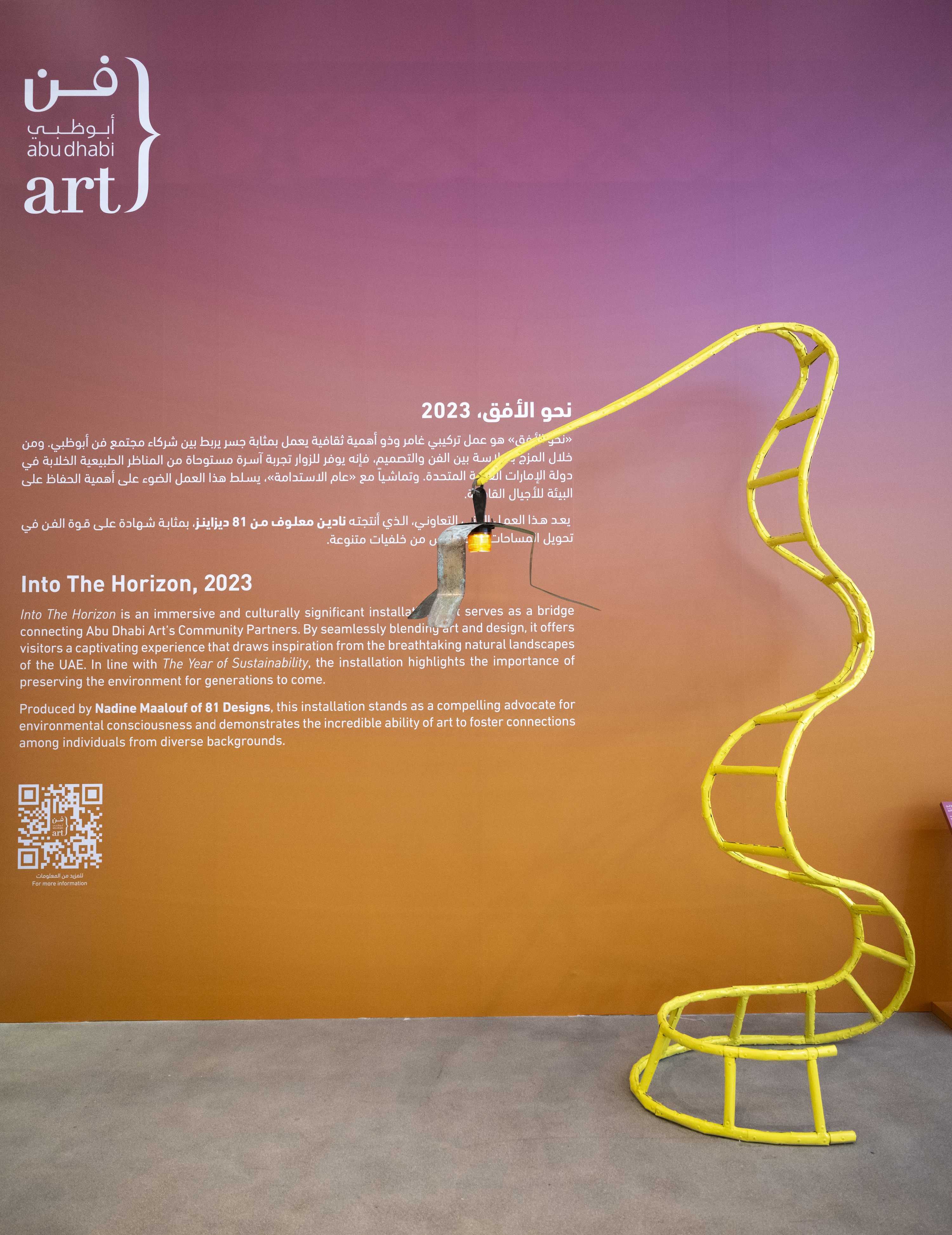
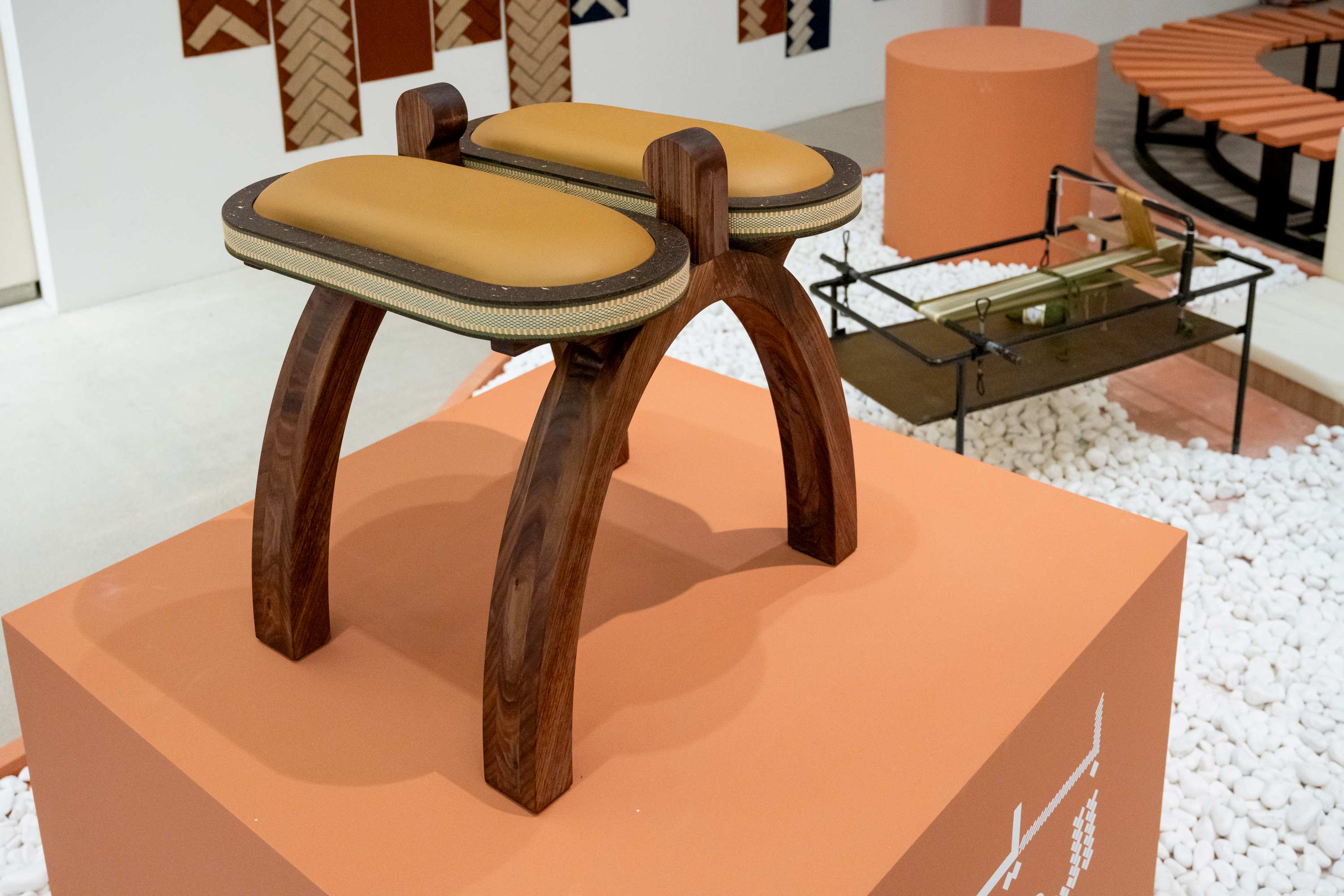
House of Artisans
Al Shedad, 2023
Stool: hand-made roasted and pulverised date seed DATEFORM sheets and hand-woven Sadu
55 x 55 x 55 cm
Courtesy of House of Artisans, Abu Dhabi
“Al Shedad” is a unique stool that has been thoughtfully designed by House of Artisans, drawing inspiration from the practical and functional seating traditionally utilised by Bedouin nomads during their travel journeys. The piece of furniture not only pays homage to the rich cultural heritage of the United Arab Emirates but also incorporates sustainable materials, including hand-made roasted and pulverised date seed sheets. The stool features a strap of hand-woven Sadu, which is a traditional form of weaving practiced by Bedouin women in the UAE. Using the wool of sheep, camels, and goats, women create beautiful and distinctive designs rich with geometrical patterns that often reflect both social identity and the surrounding environment.
The design of “Al Shedad” is a testament to the House of Artisans’ commitment to preserving traditional Emirati handicrafts while embracing sustainable methods. The Sadu used is hand-woven by a skilled Emirati artisan. The Sadu pattern featured in this piece is known as “Thuraiyah”, which takes inspiration from the stars constellations that the Bedouins relied on to navigate and track seasonal changes.
For more information, visit HOA website at: https://qasralhosn.ae/en/house-of-artisans
National Multiple Sclerosis Society
Maitha Al Omaira
How is nature constant when the sun never rests, 2023
15 gypsum casts
23 x 25 x 7 cm (each)
Courtesy of the artist and The National Multiple Sclerosis Society
Curated by Dirwaza Curatorial Lab and Spacial Design by Alla Abdunabi
A two-part installation commissioned by The National Multiple Sclerosis Society in the UAE. Al Omaira responds to themes that correspond with the goals of the Society, which are dedicated to shedding light on the journey of individuals living with Multiple Sclerosis (MS). The work further aims to unpack and highlight the complexities of the human body, with all of its intricacies. The installation transposes forms found in the nervous system and the natural world – drawing out a map that uncovers and bridges body and nature.
Additionally, the work connects the cycles of change in nature with that of the human body. Through casting different parts of the ground around her, using the medium of alginate, the artist creates building blocks that store memory of a surrounding environment. The resulting composition of alginate casts uniquely capture different stages and parts of the local flora and fauna which surround the artist. Al Omaira uses natural materials to cast the ground, and then proceeds to recast the negative space with plaster. Through the installation, both material elements, the casts and the video are built in a way that connects and reflects on the consistency of change found in both nature and MS.
The physical scans of the ground pick up the stories and the traces left behind. Parallels between the artistic process and the journey of someone living with MS may be drawn in the mirroring of the flow of information between the body and brain. Al Omaira freezes the motions of nature within the casts as a means to confront these realities through renegotiating perspectives. No two casts are the same, which also speaks to vastly differing journeys and symptoms that people living with MS might have. Furthermore, through the video, the artist works by emotionally experimenting with nature and questioning its perspective norms to introduce an atypical view of the sky by looking at it downwards. This is reflective of one of the challenges experienced by many living with MS, which is that they do not visually fit wider society’s conventional perspective of someone living with a long-term serious illness.
For more information, visit NMSS website at: Nationalmssociety.ae
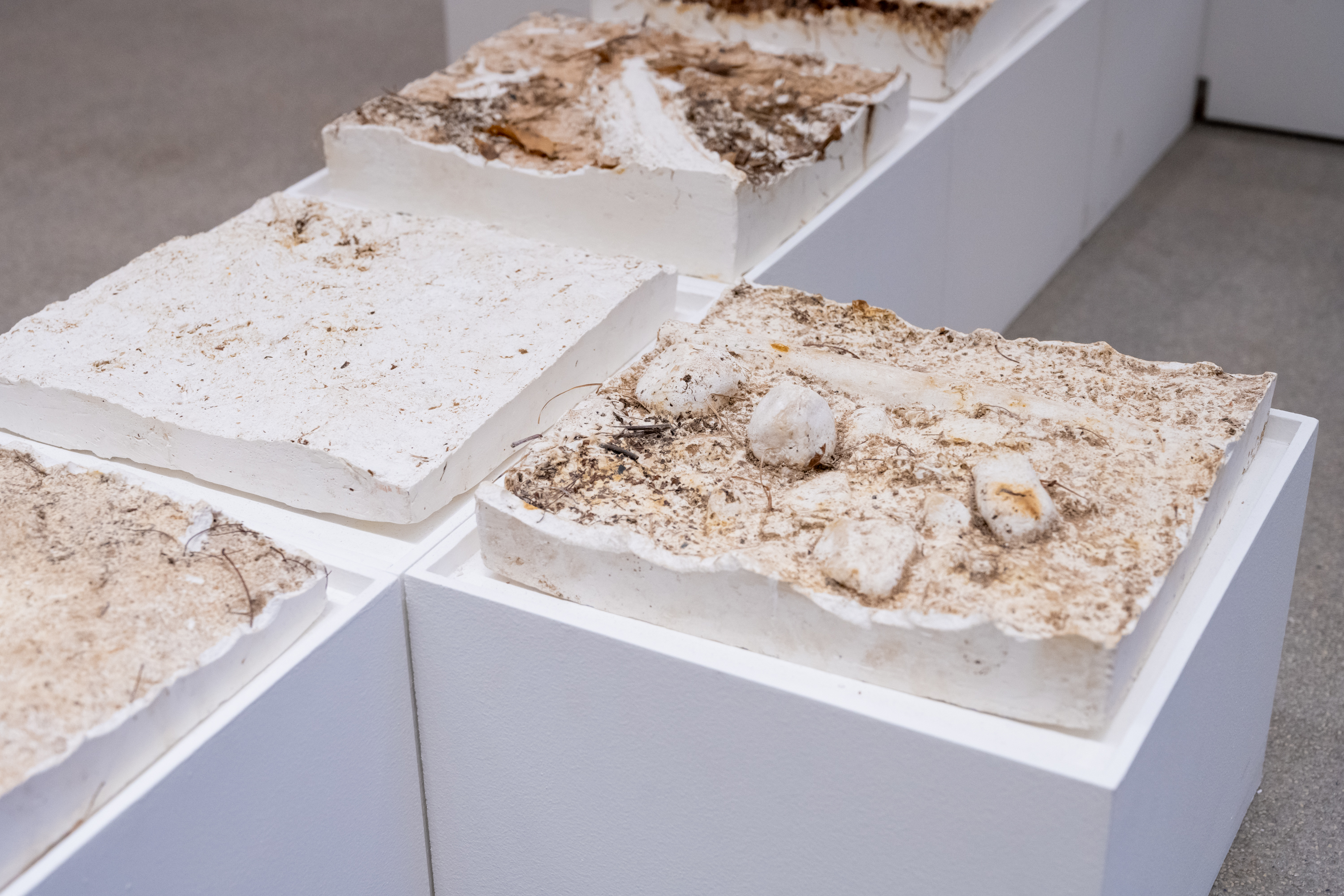
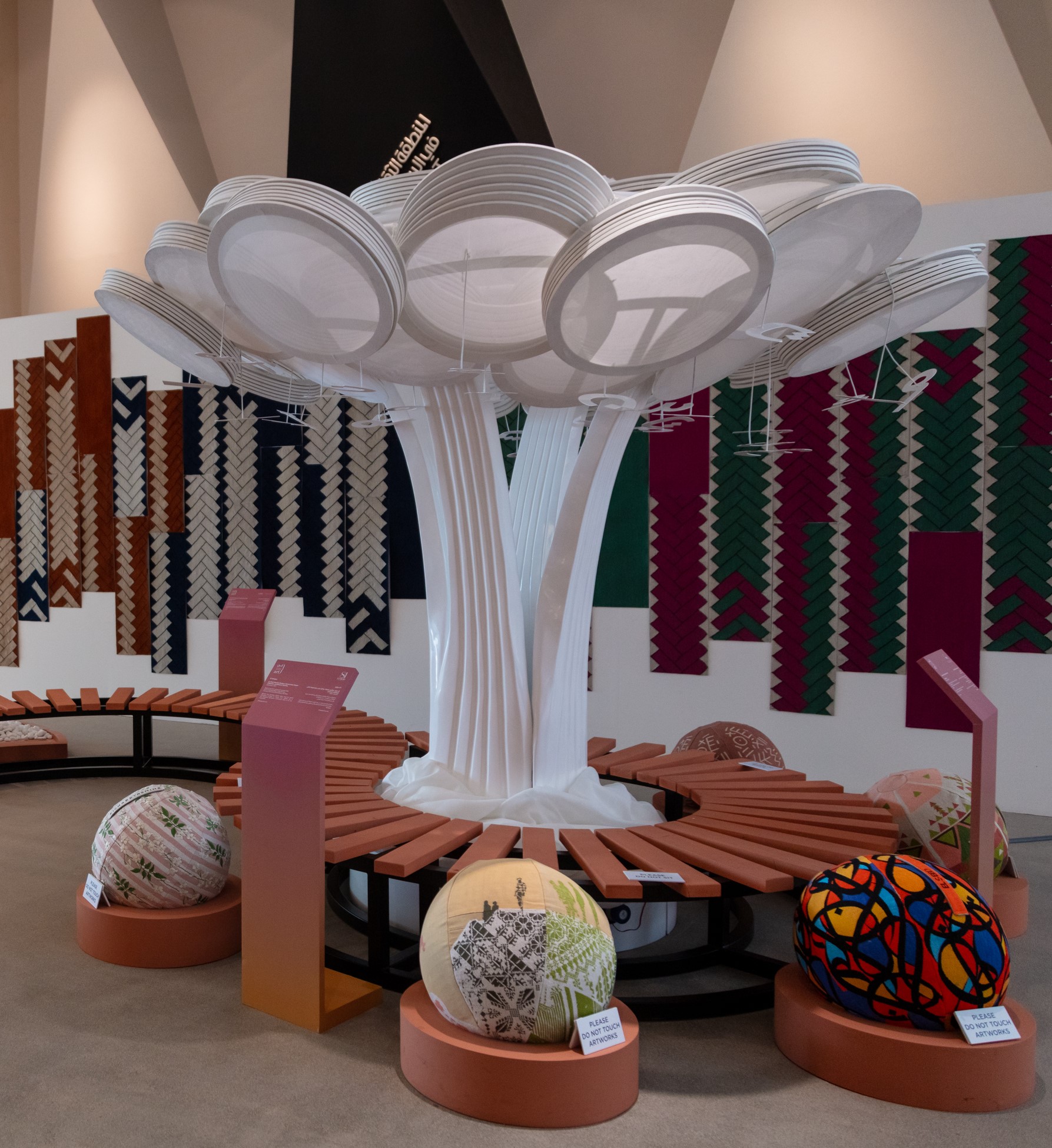
Authority of Social Contribution – Ma’an
Dana Achkar
Rooted Together, 2023
Wood base, fiberglass tree trunk & aluminum spiral ring with fabric
Dimensions variable
Courtesy of the artist and Authority of Social Contribution - Ma'an, Abu Dhabi
A sculpture crafted from intertwined metal branches, depicting the intricate branches and leaves of the Ghaf tree. This artwork serves as a symbolic gateway, inviting visitors to step into a realm where art and nature seamlessly intertwine. As the light moves throughout the day, the sculpture casts enchanting shadows on the ground, creating an ever-changing play of light and form.
For more information, visit Ma.an website at: maan.gov.ae
Weaving Alliances
Seat at the Table, 2023
Artisanal stools interconnected with Talli on Khous woven carpet
Size of each seat: Base: 35 cm; 70 (h) cm
Size of the Khous carpet: 160 cm
Courtesy of Alghadeer UAE Crafts and Rwanda Arts Initiative, Abu Dhabi
Curated by May Barber
An art installation crafted by artisans from the United Arab Emirates and Rwanda, embodying the urgent need for more diverse representation and collective inclusion in the climate discourse.
Crafted by skilled artisans from Rwanda using locally sourced agave and papyrus, each seat within this installation represents a profound symbol of inclusion, representation, and participation. The table of negotiations, symbolised by the Khous carpet woven by UAE artisans, becomes a gathering place for discourse and collaboration. The artisanal seats symbolise the need to provide space and recognition for diverse perspectives in shaping the path to a more sustainable future, while rooted in a much-needed spirit of solidarity and unity, symbolised by the Talli-ropes, woven by UAE artisans. The rich cultural heritage and craftsmanship woven into every detail serve as reminders that our response to climate change must be rooted in a collective and holistic understanding of the world we share.
Through this installation, we aim to amplify the voices of these communities who possess invaluable knowledge, insights, and resilience, while offering a platform for dialogue and collaboration that transcends boundaries and challenges preconceptions.

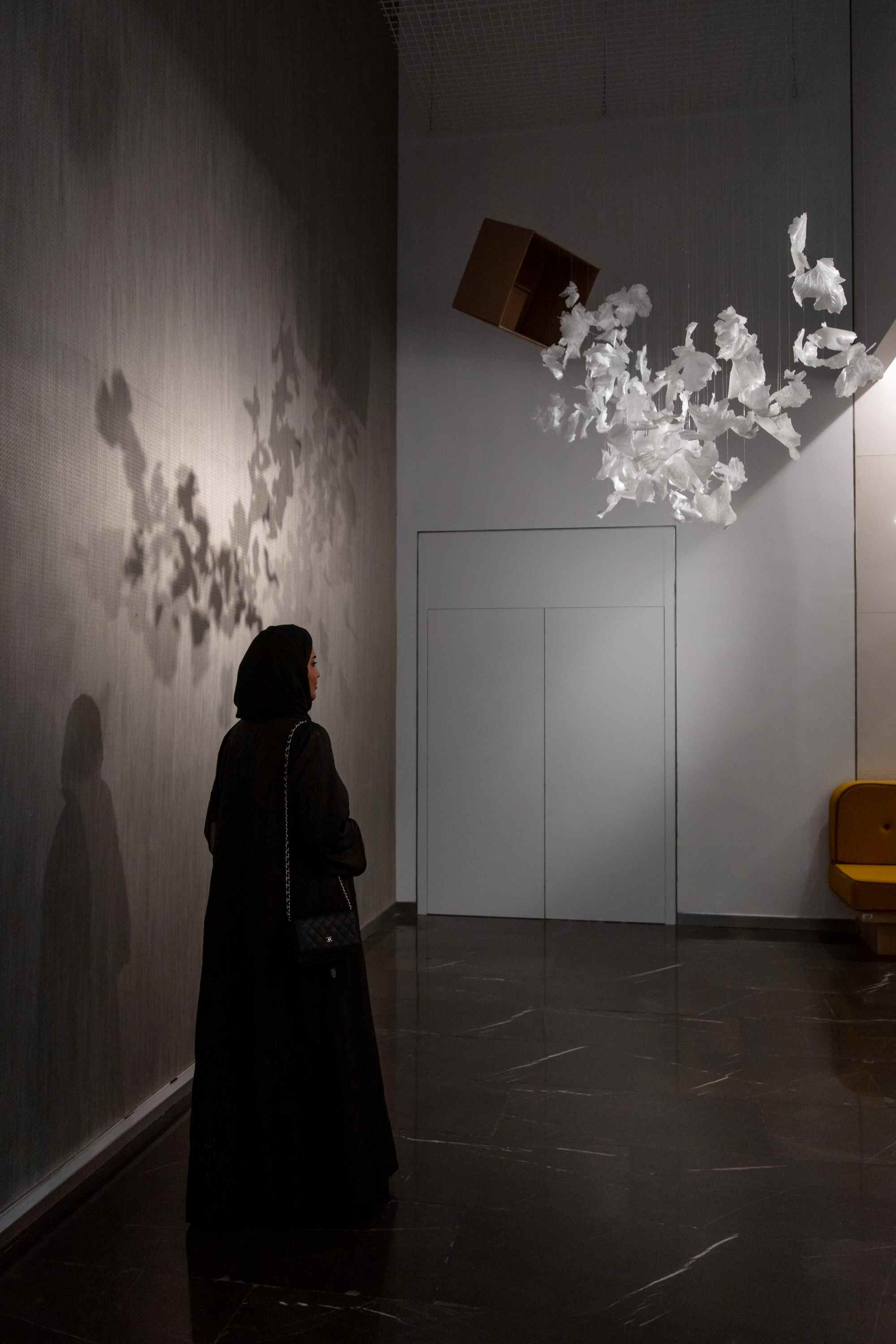
Maraya Art Center
Sawsan Al Bahar
Absent Fall, 2023
3D printed transparent PLA/resin and fish wire
Dimensions variable
Courtesy of the artist and Maraya Art Center, Sharjah
This work is the latest in a series of site-specific installations in which Sawsan Al Bahar (b. 1989, Damascus, Syria) plays with the visible and the invisible. The artist creates a sculptural spectacle with 100 transparent tree leaves. Each leaf is uniquely made through image mapping, then 3D printed and moulded by hand. The suspended vertical fall of transparent leaves floating mid-air creates an evocative image of lost fall leaves.
The delicate ghostly sculptures express fragility and temporality - foregrounding the intangible forces of time, gravity, and air. Viewers experience form as both absent and present. Seen from different viewpoints, the leaves oscillate between appearing and disappearing momentarily, suspended in a state of both movement and rest.
The purposeful use of artificial materials highlights and challenges our relationship with the natural world. We experience machine-made, handmade and natural simultaneously. The transparency is a reminder of the ephemeral nature of the artwork but also of nature and life itself.
For more information, visit Maraya art center website at: maraya.ae
Irthi Contemporary Craft Council
Talli Weaving Wall, 2023
Interactive weaving metal wall Installation, camel leather threads
Dimensions variable
Courtesy Irthi Contemporary Crafts Council, Sharjah
In the continuous efforts to preserve and encourage the community to engage with Emirati crafts, the Talli Weaving Wall has been introduced as an interactive installation to raise awareness of one of the main crafts in the UAE.
“Talli” is an art of braiding that has been practised by women in the United Arab Emirates, similar in technique to bobbin lace. Talli was traditionally created by Emirati women in their homes to decorate the hems and cuff of their clothing. Talli’s complex design of fine patterns is created with a combination of cotton and metallic threads called “khosa” that are braided to create the textile. Today, Irthi Contemporary Crafts Council has developed and reinterpreted the traditional craft and produces over 50 different styles of Talli, in a varied range of colours and materials, created by the skilled female artisans of Irthi’s Skills Development Programme.
For more information, visit IRTHI website at: irthi.com
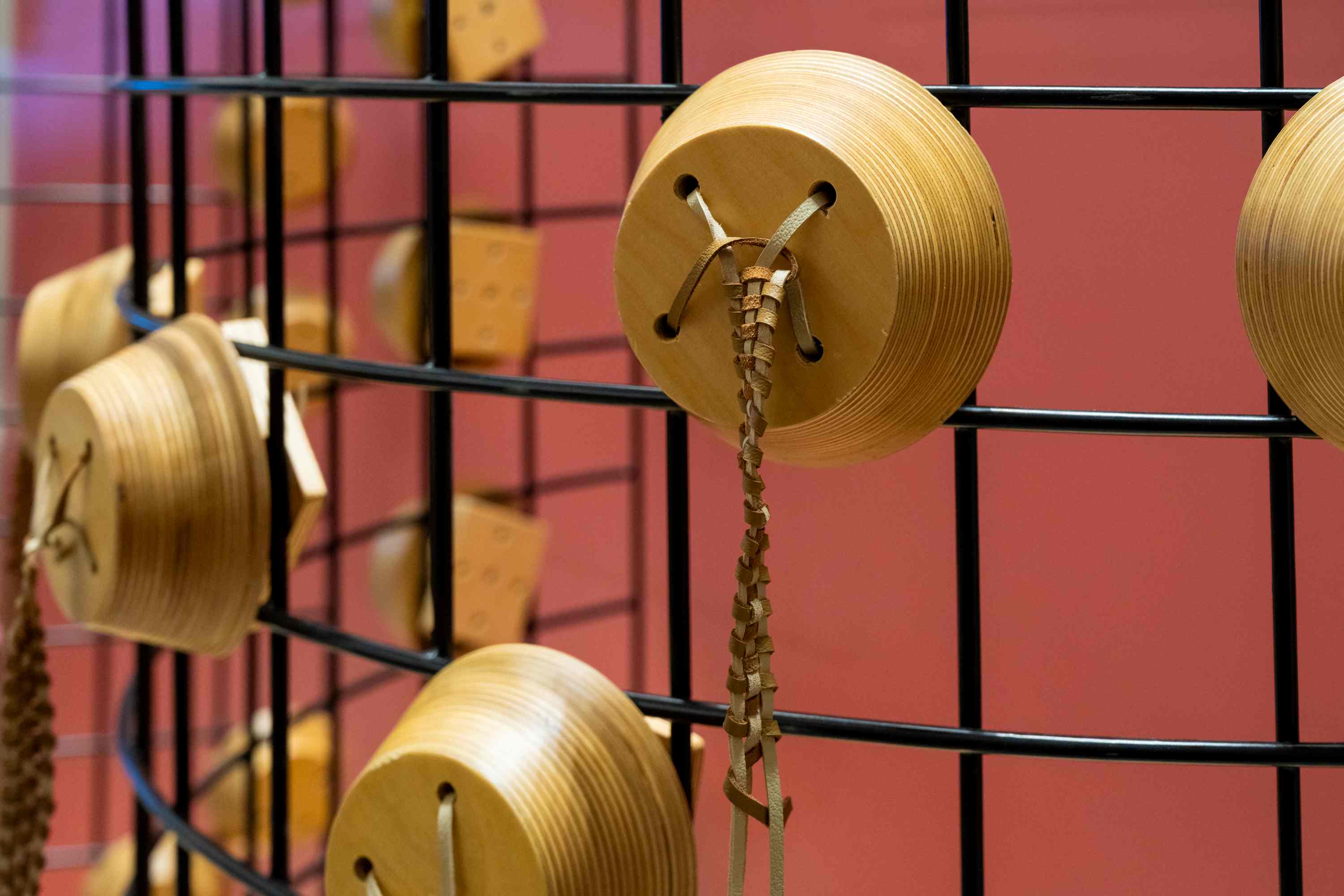

Fatima Bint Mohamed Bin Zayed Initiative
Roudha Al Shamsi
NSJ, 2023
Kilim carpets, mimicking Khoos-like arrangements
30 x 120 cm
Kilim carpets series
Courtesy of the designer and Zuleya by the Fatima Bint Mohamed Bin Zayed Initiative, Abu Dhabi
There has always been a connection between humans and the notion of hand-made, dating back to the deepest roots of humanity. The imperfections and hand gestures found in handmade crafts hold great value and carry through emotions and personality.
Zuleya by the Fatima Bint Mohamed Bin Zayed Initiative in collaboration with Roudha Al Shamsi present NSJ. NSJ is an artwork that is made by Afghan weavers to tell the stories of the Emirates, with the aim of empowering underprivileged communities – with a strong focus on women – by providing them with sustainable employment and critical social services. The initiative has four main pillars: Arts & Culture, Education, Health, and Strategic Advisory. Weaving is one of many crafts by which stories of nations are told; culture, traditions and values. Weaving is both a worldwide language and also indigenous to each nation.
NSJ is an assorted series of Kilim carpets, mimicking Khoos-like arrangements, weaved together in irregular patterns resulting in an infinity of lengths and widths.
For more information, visit FBMI website at: fbmi.ae
Alghadeer UAE Crafts
Loreta Bilinskaite-Monie
Tirhal ‘Journey’, 2023
Sadu using sustainable materials
The white bench: 375 x 55 cm
The orange bench: 450 x 55 cm
Courtesy of the designer and Alghadeer UAE Crafts, Abu Dhabi
Tirhal ‘Journey’, created in 2023, was first shown as part of London Design Fair earlier this year. The collection presents five sculptural benches woven by 16 Bedouin women using traditional Al Sadu weaving techniques from sustainable materials.
The Tirhal Collection was conceptualised by Lithuanian-born textile designer Loreta Bilinskaite-Monie. It is a tribute to traditional Emirati design brought to life with contemporary aesthetics, encapsulating the journey from ancient tribal roots to a modern innovative society.
At the heart of the Tirhal Collection lies the skill and talent of 16 Bedouin women who are among more than 300 artisans who have taken part in the Alghadeer Emirati Crafts programme. These skilled artisans intricately handmade each piece using sustainable materials, including locally sourced sheep's wool and natural dyes. The collection celebrates the deep-rooted cultural practice of Al Sadu weaving, an age-old tradition through which women transform wool from their sheep into exquisite decorative furnishings such as tent dividers, cushions, and pillows.
For more information, visit Alghadeer website at: alghadeeruaecrafts.ae
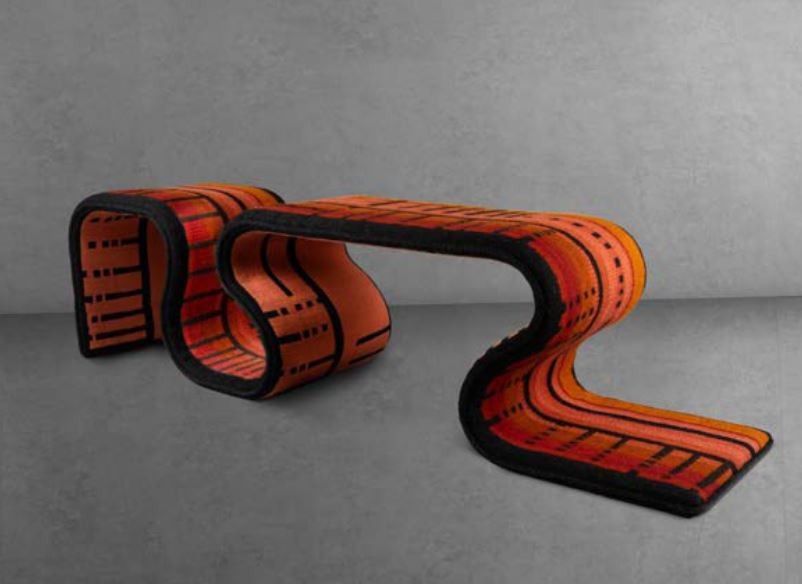
Ministry of Foreign Affairs
José Yaque
Sodalita con impurezas II,2022
Azufre con impurezas II, 2022
Acrylic on canvas, 220 x 190 cm
Courtesy of GALLERIA CONTINUA
The Ministry of Foreign Affairs has chosen to spotlight the artist José Yaque (Galleria Continua) for the Community Section of Abu Dhabi Art, which this year explores the theme of Sustainability and our relationship to the natural environment.
José Yaque was born in Manzanillo, Cuba, a coastal city where nature was instilled in him as an important reality, a never-ending source of meaning and inspiration. Yaque grew up with the sea before him. Horizontality therefore finds a recurring place in his work. From his point of view, nature is the greatest creator in our lives.
The artist researches the origin of colour which is deeply explored in his works. This study consequentially led him to learning about the geological universe under the earth, rock types and minerals, initiating a dialogue with an underground world.
With his close connection to nature, in particular to the earth and the sea, Yaque brings to the fore the symbiotic relationship humans have with the world they inhabit and that they have a shared responsibility toward.
